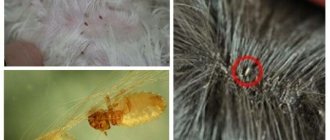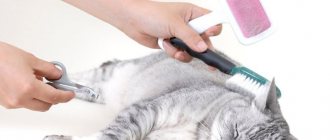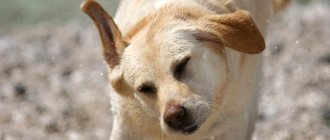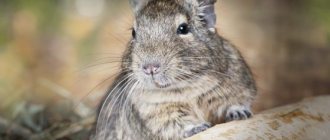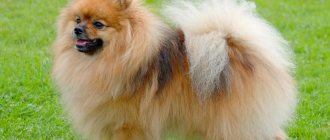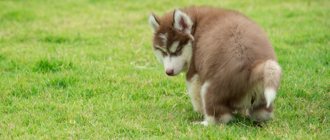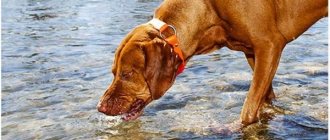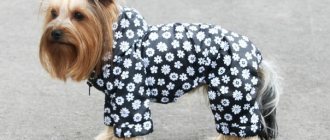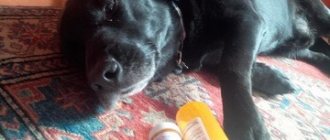Trichodectosis is a parasitic disease of dogs, the development of which is provoked by lice eaters.
Ectoparasites of this species have tiny sizes, not exceeding one and a half to two millimeters, a translucent or yellowish abdomen, and a disproportionately large head.
A distinctive feature of lice-eaters that parasitize the skin is the specificity of their diet: if the food source for common blood-sucking parasites is blood, then these pests prefer skin particles, dog hair, and fluff.
When infected with skin parasites, the dog shows constant anxiety, constantly itches, appetite and sleep deteriorate, and sores and scratches may appear on the skin. It is imperative to treat your dog using insecticides. We will consider below what methods will help get rid of parasites.
What are lice eaters?
Lice eaters in dogs are small insects that parasitize exclusively on the skin and fur of the animal. Ectoparasites are extremely small in size; the body length of an adult does not exceed two millimeters.
A distinctive feature of insects is their large rectangular head, flat body, and transparent integument. It is extremely difficult to detect lice eaters on a dog’s body; this can only be done through a close examination of the fur.
The reproduction process of these parasites is similar to lice and fleas: the female lice-eater lays several dozen eggs, attaching them to the fur using a special adhesive substance. Due to this factor, it is extremely difficult to get rid of parasite eggs by combing or washing. The only food sources for lice eaters are particles of skin, fur, and dried blood.
Entomoses are hair suckers in cats and dogs. Treatment and prevention
No one wants to see lice and fleas on their pet, as these parasites can bite not only pets, but also humans. They cause intense itching and scratching, and in severe cases, dogs and cats literally go into a frenzy, trying to get rid of the source of the itching that torments them. In addition, all these parasites “successfully” act as carriers of many infectious and parasitic diseases. In a word, entomoses of our cats and dogs (this is the collective name for cases of “flea infestation”, “lice infestation”, etc.) are serious pathologies; bloodsuckers must be destroyed immediately.
Ways to combat lice eaters
When lice bites appear in a dog, treatment is required. Integrated control of parasites includes treating animal fur with special insecticidal agents that have a detrimental effect on adult parasites, larvae, and eggs. You can also use folk remedies, but more often their level of effectiveness is extremely low, and therefore it is better to use them for preventive treatment of wool.
Anti-hairworm medications for dogs
Before removing lice eaters from a dog through the use of antiparasitic agents, it is necessary to show the animal to a specialist.
Incorrectly selected medications can aggravate the symptoms and condition of the pet. Any means are selected according to the age characteristics of the animal, its breed, and the degree of infection.
Pediculicidal shampoos
Pediculicidal shampoos are moderately effective treatments against lice. Their advantages include softness and safety of action. Shampoos can be used to remove skin parasites from puppies and animals that are hypersensitive to aggressive insecticides. The most popular types are: Meadow, Phytoelite, Celandine.
To carry out anti-parasitic treatment of a dog, it is enough to apply a small amount of detergent to the coat, lather thoroughly, and then remove. After rinsing, it is important to comb out the parasites using a sparse comb.
It should be noted that shampoos actively moisturize the animal’s skin, promoting the healing of microdamages, hydration, and relieving itching.
Drops against lice
Drops for dogs against lice are among the highly effective products. A single use of drugs from this group allows you to rid the animal of parasites for several months and prevent re-infection. Before curing a dog of lice with drops, it is important to make sure that there are no wounds or damage on the animal’s skin.
Drops against lice with increased effectiveness are:
- Advantage.
- Snow leopard.
- Leopard.
To carry out the procedure, it is enough to apply a few drops of the selected insecticidal preparation to the withers area and allow the product to absorb into the skin. It is important to ensure that the medicine does not enter the animal’s digestive tract.
Pills
The easiest way to treat lice in dogs is to use chewable tablets. Drugs in this group have a pleasant taste, their duration of action ranges from one month to three. The tablets are completely safe for use, but have an average level of effectiveness.
Antiparasitic sprays and aerosols
Sprays and aerosols that have antiparasitic properties contain components similar to those contained in the drops. The advantage of spray products is the ability to apply over a large area.
To destroy lice eaters, the following types of aerosols are most often used: Defendog, Blokhnet. Before use, it is important to put a restrictive collar on your dog; this measure will help prevent toxic substances from entering the animal’s digestive tract.
Collars
The easiest way to treat lice eaters is to use antiparasitic collars. To get the effect, just put a collar on the animal. Before getting rid of lice in dogs in this way, it is recommended to bathe the animal using any insecticidal shampoo during the procedure. It should be noted that collars are excellent for preventing your pet from becoming infected with parasites.
Folk remedies
If for some reason the use of the insecticidal agents given above is not possible, folk remedies will help to cope with parasites.
The following are suitable for use at home:
- herbal decoctions. To carry out antiparasitic treatment of an animal, it is recommended to bathe the dog using a rich decoction of chamomile, string or wormwood.
- Dust soap. Works similarly to antiparasitic shampoo. To remove parasites, just thoroughly lather the animal's fur, wait a few minutes, rinse, and then comb out the insects.
It is recommended to use folk remedies only if there are a small number of parasites, since their effectiveness is low.
Basic information
As a rule, ectoparasites do especially well in situations where animals are kept in close and crowded conditions. In addition (and unfortunately), lice and fleas often appear on animals that often participate in exhibitions. The reason for this is unsatisfactory veterinary control and the lack of disinsection of exhibition premises after receiving the next batch of animals. From pet to pet (most often) parasites are transmitted through direct contact, but for the same fleas, infection occurs when a cat/dog ends up in a room where there are parasite larvae.
The life cycle of bloodsuckers of different species can differ significantly from each other. So, unlike fleas, lice survive their entire life cycle on an animal . Adult female insects lay eggs, sticking them tightly to the hair shafts. In the literature they are often called “nits”. Since they have a “camouflage” color, only an owner with certain experience can see signs of infection at first glance. Nymphs emerge from the eggs, an intermediate stage. They look like adult lice, reduced in size several times. They molt several times and become adults. The entire development process from egg to adult takes 2-4 weeks. The life cycle of lice eaters is approximately the same.
Symptoms of canine lice infestation
The appearance of lice eaters in dogs is fraught with the development of characteristic symptoms.
The following signs may indicate that an animal is infected:
- The animal shows constant anxiety, loses weight due to lack of appetite and severe thirst.
- Due to constant severe itching, scratches, wounds, and painful crusts may appear on the animal's skin.
- The condition of the coat deteriorates, it becomes duller, tangles form, and bald patches may form. In addition, small, whitish translucent dots appear on it - this is exactly what insects look like.
- Parasites can also be identified if there are dark dots on the fur, which are traces of the vital activity of parasites.
Lice eaters are especially often localized on the inside of the thighs, at the base of the tail, and head.
If the above signs appear that may indicate an invasion, the indicated areas should be thoroughly inspected.
Ways of infecting dogs with lice eaters
A common way for a healthy dog to become infected is through contact with a sick animal. A pet can become infected from other dogs by walking in a place where a sick animal was previously walked. When the first signs of infestation appear, it is important to immediately identify parasites in your pet.
Weakened dogs that do not receive enough important microelements from food are especially susceptible to infection. Also at risk are puppies, females during pregnancy, and old animals.
Possible complications
Long-term infection of a dog with lice eaters can cause the development of dermatological diseases, the appearance of wounds and scratches on the pet’s skin. It is possible to develop helminthiasis, which is carried by parasites. Due to severe itching, the animal becomes irritable and aggressive. In addition, exacerbation of chronic diseases, if any, is likely.
Preventive actions
To prevent the appearance of lice in dogs, you should promptly pay attention to the prevention of parasitic infestations. It is important to protect the animal from contact with stray relatives, and to avoid walking in places where there may be a large number of such dogs.
You need to monitor your pet’s diet; she should receive a sufficient amount of vitamins, minerals, and other important substances. No less important is the condition of the pet’s skin. Low level of hygiene, the presence of wounds, scratching can be considered among the factors contributing to the rapid increase in the number of parasites.
If your dog constantly walks outside, it is recommended to periodically use anti-parasitic shampoos and collars for prevention. These products will help protect your animal from infection for several months.
How to get rid of the parasite?
To combat these insects, modern drugs that can destroy mites are used. Popular insecticides generally act only on sexually mature individuals. The larvae remain in perfect order. This should be taken into account and the preparation should be used to treat wool at least 2-3 times. It is important to maintain a time interval of a week. During this time, the eggs mature and insects hatch from them, which can be affected by the product.
The most popular drugs: Gomelin, Oksamate and Tkringin. Also effective are sprays that are very convenient to use: Tsiodrin, Acrodex, etc. In addition to the main therapeutic agents, one should not forget about preventive measures, which sometimes play a decisive role.
It is important to monitor the cleanliness of your pet's bedding and regularly inspect your pet for foreign matter in the fur. It is recommended to wash floors with chlorine-containing products at least 2 times a week.
It is necessary to limit contact with the dog during treatment. We need to monitor her condition. If it does not improve, you should immediately contact your veterinarian.
